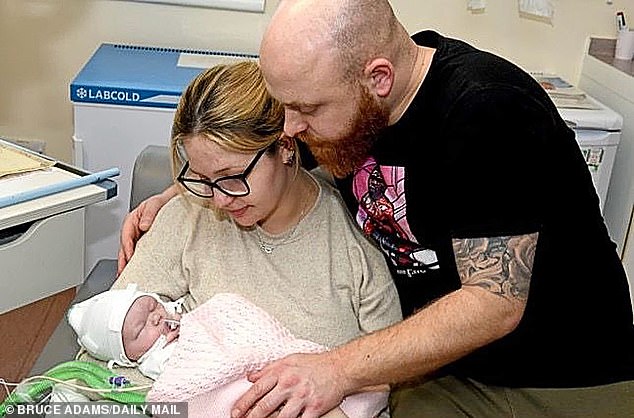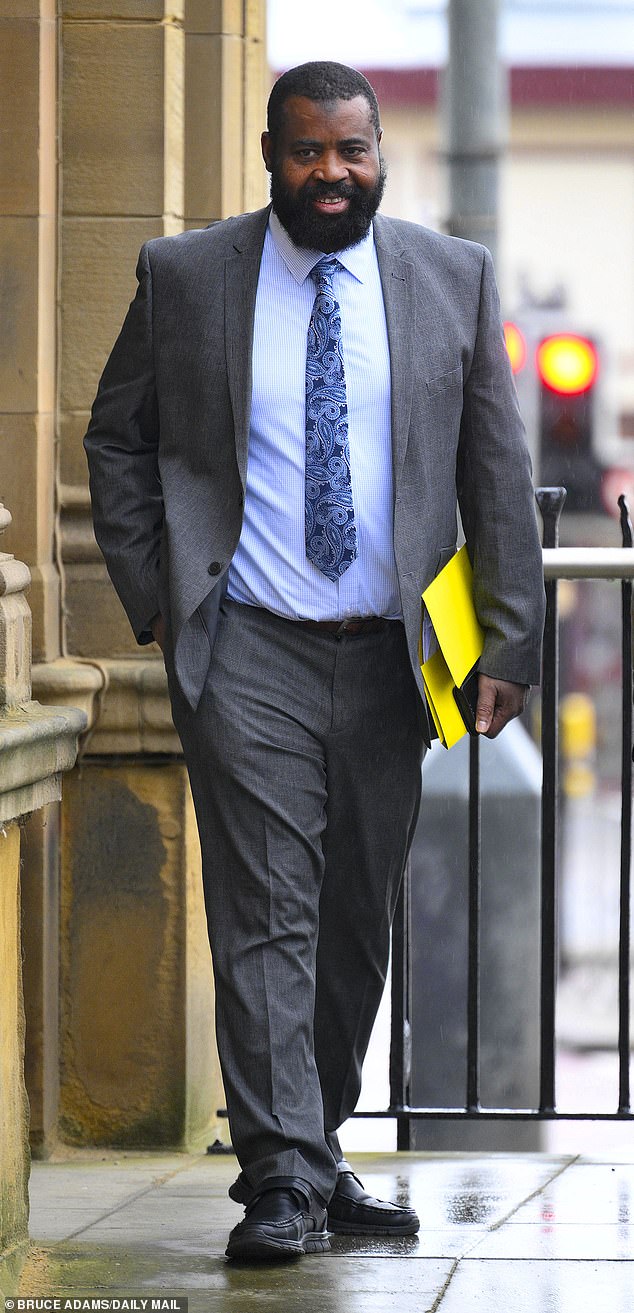A baby girl died after a locum obstetrician refused to send her mother to theatre for a Cesarean despite signs the baby’s heartbeat was abnormal.
Two midwives expressed concerns for 27-year-old mother Shannon Lord after cardiotography (CTG) scans showed up as abnormal as she was about to enter labour.
But obstetrician Muhammed Sandow told them he had seen similar CTGs return to normal and opted to wait another 30 minutes.
A Cesarean was eventually carried out in the early hours of the morning when Shannon’s baby Ayla was born one and a half hours after concerns were first raised.
She was floppy, pale, not breathing properly and suffered seizures. She died at 13 days old.
Blackpool Teaching Hospital in Lancashire has accepted failings were made in the care of Ayla and her mother and the outcome might have been different if the Caesarean had been carried out earlier.
Shannon and partner Dayle Newton, 36, both adult support workers, said in a statement: ‘We were not made aware of any concerns with Ayla’s health until she was delivered floppy, pale and not breathing.
‘This was extremely traumatic. We didn’t know what was going on. A few days after our beautiful little girl was born, we had to make the decision to withdraw her care as a result of severe brain damage.

Baby Ayla died after a locum obstetrician refused to send Shannon Lord, 27, to theatre for a Cesarean despite signs the baby’s heartbeat was abnormal

Ayla’s parents, Shannon and partner Dayle Newton, 36, said ‘it is devastating to know now that had the midwives’ repeated concerns been actioned, Ayla would be with us today’

Obstetrician Muhammed Sandow told them he had seen similar CTGs return to normal but Ayla was born floppy, pale, not breathing properly and suffered seizures
‘We sat with our girl in our arms for eleven hours watching her slowly die.
‘We are extremely angry and will never get over the loss of our first child together.
‘We do not understand why this has happened. We trusted the hospital to keep Ayla safe and to deliver a healthy baby.
‘It is devastating to know now that had the midwives’ repeated concerns been actioned, Ayla would be with us today.’
The family have since had another baby girl and opted to avoid Blackpool Victoria Hospital travelling to the Royal Preston Hospital instead.
An inquest in Blackpool today heard how there was ‘no conflict’ on the ward after Dr Sandow’s decision but midwife Jennifer Fogg told coroner Margaret Taylor how she had some misgivings over it.
She first raised her concerns at 3.38am when the first CTG was abnormal and wanted it reviewed after five minutes. Dr Sandow did not authorise a c-section until 4.25am.
Miss Fogg said: ‘It was a difficult situation. I felt I was right to escalate my concerns but he said he had seen similar CTGs before and that it might normalise.

An inquest in Blackpool today heard how there was ‘no conflict’ on the ward after Dr Sandow’s decision but midwife Jennifer Fogg told coroner Margaret Taylor how she had some misgivings over it
‘He is an experienced obstetrician and he also mentioned that there are also risks associated with Caesareans.
‘But I had a gut feeling something was wrong. I just had a really bad feeling.’
Asked about Dr Sandow – who she still works with – Miss Fogg added: ‘I think he is a very valued and trusted doctor.
‘It was not the right decision that day but Dr Sandow has made many right decisions over the years and saved the lives of many mothers and babies in his time.
‘He is a very competent doctor.’
The inquest heard Shannon went in to the Blackpool hospital in January 2023 when she was overdue although the it had been a perfectly normal pregnancy.
All CTGs scans were normal until just after she entered the delivery suite at around 3.25am. When it continued to appear abnormal the midwives alerted Dr Sandow who then made his decision to wait.
He told the inquest he had seen two CTGs scans before that normalised within forty minutes.

‘We sat with our girl in our arms for eleven hours watching her slowly die,’ the couple said, adding ‘we are extremely angry and will never get over the loss of our first child together’
But he added: ‘Looking back, if I had a similar case again I would call the consultant and say we ought to be preparing for a c-section.
‘I should have taken action earlier.’
Dr Sandow then broke down as he gave evidence, adding ‘in 15 years of practice this case is the one that has taught me the most lessons’.
‘I have changed my practice. Now I would contact the consultant right away if I had a difference of opinion with a midwife.
‘I should not have waited 30 minutes.’
In tears he added: ‘I want to extend my condolences to the family. I wish I …’. The family are pursuing a civil action against the hospital.
Representing them, stillbirth and neonatal death solicitor Eleanor Rostron said: ‘Medical professionals should be aware that even in low risk normal pregnancies things can still go catastrophically and unexpectedly wrong up to the early days and weeks after a baby’s birth.
‘The midwife reviewed the CTG, and correctly recognised potential fetal distress demonstrated by the severely abnormal CTG reading. She escalated her concerns to the locum obstetrician who was ultimately responsible for Shannon’s care.

‘It was not the right decision that day but Dr Sandow has made many right decisions over the years and saved the lives of many mothers and babies in his time,’ a midwife said
‘Remarkably, the obstetrician disagreed on the basis of having experienced different pregnancies where a baby’s abnormal heart rate had normalised expecting that the same would occur during Shannon’s care.
‘His approach was to ignore the concerns raised by several midwives. Sixty minutes following the first signs of an abnormal heart rate in an unborn child is a significant amount of time during which catastrophic brain injury can occur.
‘A baby can tolerate around ten minutes from the signs of distress first appearing before brain damage begins. There is no safe medical reason to ignore a pathological heart rate reading for one hour – particularly given that 26 minutes had already passed since the heart monitor was started.
‘In this critical window during which Ayla could and should have been saved.’
Ayla’s heart rate consistently showed abnormalities. The obstetrician was repeatedly alerted to the concerns of multiple midwives. He ignored their concerns on the basis of a dangerous assumption and against national standards and guidelines.
‘We cannot understand the logic of ignoring danger signs when good care was simply continuing to watch the CTG reading for a few more minutes before timely action to deliver Ayla before serious harm was caused.’







